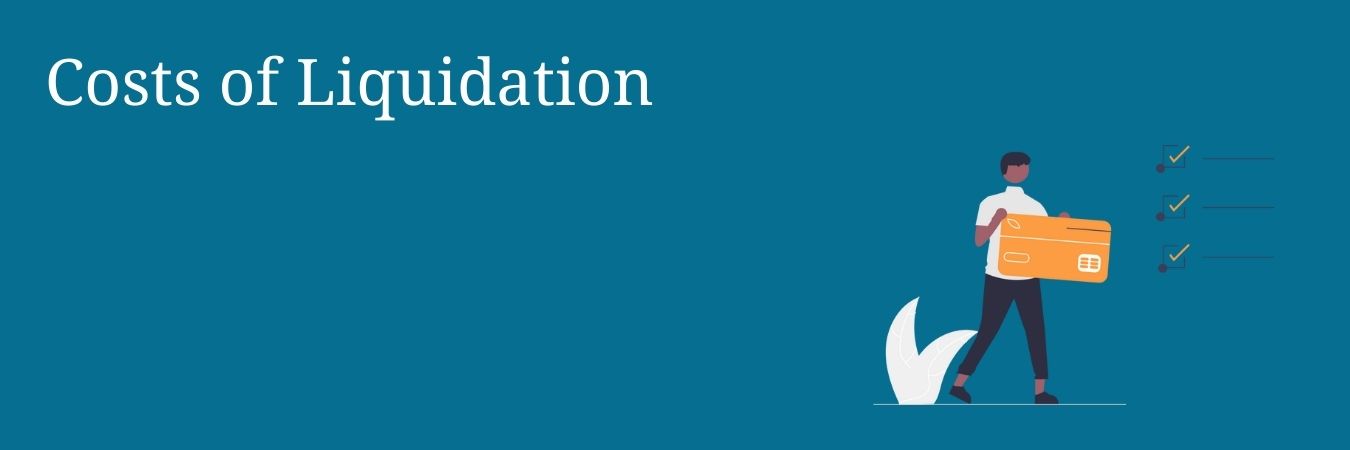If you are thinking of closing an insolvent company, then the costs of liquidation are likely to be one of your biggest concerns.
When the company is already struggling financially, the last thing you want is to incur another cost. However, the benefits of choosing to liquidate the company voluntarily make this sort of closure the most desirable way to bring an end to your company when dissolution is not an option.
The process of liquidating an insolvent company is called a Creditors’ Voluntary Liquidation (CVL).
A licensed insolvency practitioner must be appointed to control the process. It is their job to identify the company’s assets and liabilities, value and sell the assets and distribute the proceeds to those who are owed money by the company (its creditors) before it’s closed down.

Why Might you Choose a Voluntary Liquidation?
Although the liquidation process is primarily designed for the benefit of company creditors, there are also significant benefits for the company directors themselves.
If you are worried about the prospect of misconduct or wrongful trading allegations resulting from the liquidator’s investigations, choosing to put the company into liquidation yourself, rather than waiting to be forced into liquidation by a creditor, will make it less likely that action will be taken against you.
That’s due to the fact that you have taken positive action to limit creditor losses. If you leave it too late, it increases the likelihood that misfeasance will be found, which could lead to you being made personally liable for a proportion of the company’s debts and even disqualified as a director.
By entering liquidation voluntarily, you have far more control over the process. You are able to choose the liquidator yourself and decide on the most appropriate time to enter liquidation.
If you wait to be forced into compulsory liquidation by a creditor, the process will be overseen by the Official Receiver who is appointed by the Crown. That makes the process much more intrusive.
How Much Does Liquidation Cost?
The cost of liquidation depends on the complexity of the case, which is based on factors such as the company’s size and its overall financial situation, the number of creditors and shareholders and the value of its assets.
For a relatively small limited company with just a few assets, you can expect to pay in the region of £4,000-£5,000 + VAT.
For a larger company with a greater number of assets, you can expect that fee to rise considerably due to the added complexity and the extra time it will take to wind the company up.
What do the Costs of Liquidation Cover?
An insolvency practitioner must be appointed to act as the liquidator and close the company down. The cost of liquidation will cover a wide range of duties they perform during that time. That includes:
- Advising directors of their duties
- Settling legal disputes or any outstanding contracts
- Making employees redundant and processing claims for monies they are owed
- Collecting debts owed to the business, including money owed by the company directors
- Meeting deadlines for the relevant paperwork and keeping Companies House, HMRC and the Insolvency Service informed
- Investigating transactions that took place prior to liquidation
- Keeping creditors up to date with the progress of the liquidation
- Valuing and realising company assets
- Distributing the proceeds to the company’s creditors
How Can you pay the Costs of Liquidation?
Despite the clear advantages of a voluntary liquidation, some directors can be reluctant to take this approach because the costs of liquidation are simply out of reach, particularly for the directors of smaller insolvent firms.
However, it is possible to fund voluntary liquidation without any cost to the directors personally.
Under certain conditions, limited company directors can claim redundancy pay and other statutory entitlements, which can be used to cover the cost of liquidation.
The average director redundancy payout is £12,000, so it’s well worth looking into your eligibility.
If you are…
- On the company payroll
- Have worked for the company for over two years
- Have worked for a minimum of 16 hours a week for the company
… then you could be eligible. Here’s more information about director’s redundancy payments.
What if You Can’t Afford an Insolvent Liquidation?
The costs of liquidation can also be met by the sale of company assets.
Our licensed insolvency practitioners will arrange a valuation by an expert from the Royal Institute of Chartered Surveyors (RICS) before the assets are sold. The money raised can then be used to settle the liquidator’s fees.
If you’re not eligible for director’s redundancy payments and there are insufficient assets to cover the costs of liquidation, some directors choose to pay using their own personal funds.
They may choose to sell personal assets to raise the funds they need or use personal savings. If there are a number of company directors who are willing to contribute, you may be able to cover the costs without being left out of pocket.
Although paying for a liquidation using your personal funds is unlikely to be a favourable option, it’s important you consider the potential ramifications if you do not opt for voluntary liquidation and wait to be forced into compulsory liquidation by a creditor.
Need advice?
While we hope this article has answered some of the questions you have about the costs of liquidation, we know there’ll be much more you’d like to ask.
Rather than searching online, please get in touch and we’ll provide all the advice you need. You can talk about your particular case confidentially and we’ll happily provide a free initial consultation without any obligation.
